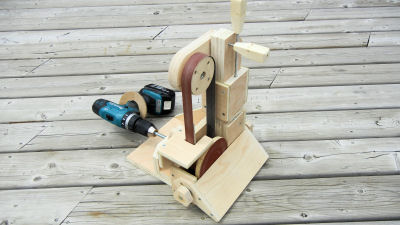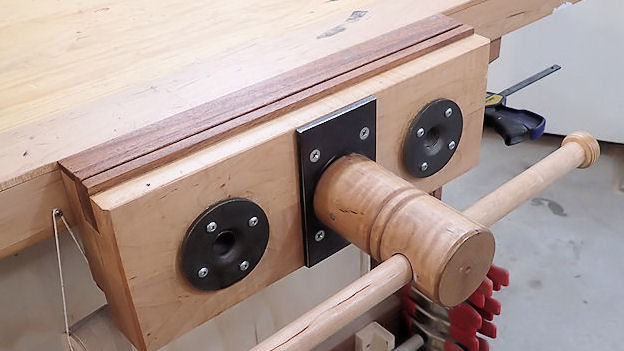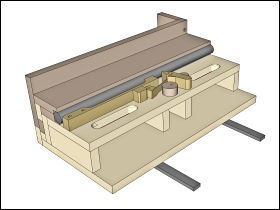Blog: All In For Some Dreaming? By: John Heisz
My new house is quite a bit smaller than my old one (now sold, by the way) and is more rural – no wired high speed internet being the biggest drawback, for me. It needs extensive renovations, and I’ll be covering that work on this site, along with the regular projects. The website statistics show that my previous renovation articles are fairly popular, and it’s a topic that I am very interested in. Besides that, I need to do the work, so I might as well document it. That work will commence shortly, but will be hampered by a fairly heavy work load over the summer (day job stuff), so I probably won’t get much done initially. That should change in the fall and winter, when I’ll have more time to devote to it.
For the time being, my new shop will be the detached garage. This is smaller than my previous shop, so it will be a tight fit for the tools I’ve collected over the past few years. On the upside, I will be in my “final destination” (no more moving, ever), so I can go wild with projects for organization and storage, and not have to worry about moving them great distances. There should be some interesting projects coming up.
Even though I could probably make the existing garage into a perfectly suitable shop, my long term plan is to build a new shop, near the back of the property. I could then use the garage as a garage, and have a small metal working area in there as well, to keep that work separate from my woodworking.
The property is a bit more than half an acre – 125′ x 200′ deep, so there is plenty of space for a good size shop. This is something I’ve been planning for more than a year, and have drawn up plans that I’ve been tinkering with, whenever I had the chance. It started out bigger, but I have brought the size down to what I think would be perfect for my needs. That is based on my previous shop size, which was nearly the right size.
Here’s what I came up with:
.jpg)
It’s a wood frame shop, 24′ x 40′.
The foundation is a concrete “floating” slab with 2″ extruded polystyrene insulation around the perimeter, and this is covered with 1/2″ pressure treated plywood.
The building won’t have any windows, but will have eight 2′ x 4′ skylights to let in plenty of natural light.
Also, it will have double doors as the entrance, rather than an overhead door. An overhead door is great in a garage, but not ideal for a workshop that you want to heat.
Since this will be an “accessory building”, the building code is not as strict as it is for an occupied residential structure. This doesn’t mean it can be poorly made, just that the risk to human life is a lot lower and the structure need not be over built. In simplified terms, it can be 80% as strong as a house. I still need a building permit and I’ll need an engineer to approve the floating slab, as it is bigger than the maximum size this type of foundation can be (20′ x 30′) without an engineer’s involvement.
.jpg)
I’ve drawn out the shop plan in great detail with SketchUp, and have included the model here for those that are interested.
The roof will use scissors truss with a 6/12 external pitch, and a 3/12 internal pitch, giving nearly 3′ of extra ceiling height at the middle.
This complicates things slightly, but I think it will be worth it.
The heating system will probably be an electric furnace, although I would like (who wouldn’t?) in-floor radiant heating. I’ll need to figure out the cost of each before deciding.
So, that is the future. I’m not exactly sure when I can get started on it, but I’m pretty sure it can’t happen this year. Maybe this time next year to get the foundation done, which would be the most difficult part. After the slab is ready, framing would go quickly and within a month, it could be closed in and water tight.
Certainly something to look forward to, anyway.
The next topic is an annoyance that is fairly new. It seems that in an attempt to “improve” the plain old boring measuring tape, they have put the design in the the hands of people who have never actually used one. I would think that at some point before production, someone who has used a tape would point out what looks to be a rather serious design flaw. Apparently not.
Let me illustrate:
.jpg)
I’ve been at Home Depot a lot lately, and on one of my visits there I saw this tape and knife combo on sale for a very attractive price. I bought it, since my old 25′ tape had broke and I needed another one, plus that knife looked pretty neat. I didn’t look the tape over closely before I bought it, thinking it looked reasonably well made, especially for the price.
When I got it out of the package, I noticed the massive ears on the hook. For someone who has never had anything more than casual use of a measuring tape, this may not seem like an issue. For those of us that have been using them constantly, for years, these extensions on the hook are a big problem.
I’ll illustrate further:
.jpg)
.jpg)
When someone who uses a tape uses it, he extends the tape out with the hand that is not holding it. He measures what needs measuring, then he releases the tape. The tape, spring loaded as it is, retracts into the case. Depending on the spring tension, this can be very rapid and forceful. The normal grip for holding a tape is trained over many years to not have fingers or other fleshy parts in the path of the retracting blade and hook…
That’s the old way, but everyone likes something new, right? In this brave new world of improved design we have Mr. Big Ears here, to set some new rules about how to hold the tape, if you like avoiding having chunks taken out of fingers and are not much into pain. The two pictures above show the places where the useless hook extensions will bite someone who has used a plain old ordinary boring run-of-the-mill measuring tape on a regular basis. I say useless because there doesn’t seem to be any reason for these extensions to be there. Do the people (person) that designed this have any understanding of what a tape measure is used for, and how to operate it? The evidence suggests the answer is “no”.
So, what’s a semi-old set-in-his-ways timer like me to do? Fix it, of course:
.jpg)
Use my tin snips to Mr. Blonde Mr. Big Ears. Brand new, retro style tape that actually works! Incredible!
Let’s not think that I’m just picking on DeWalt here, since I believe Stanley was the first manufacturer to make this particular improvement:
.jpg)
This is the “Fat Max” with the same feature, and the tape I had before – the one that broke. The ears on that one were smaller, but like the piranha, they are deceptively deadly and hungry for flesh. I cut those off as well, after walking the 40′ or so to pick it up from where it landed, after I threw it. Throwing it didn’t break it, by the way, but it did make me feel a bit better.
.jpg)
Since I’m on about things that are supposed to be improvements, but aren’t, I’ll say a word about another new development: the multi-driver screw. Oh the convenience of a screw, where the only type of screwdriver that actually fits it properly is the good old standard slotted. One step forward, three back.











